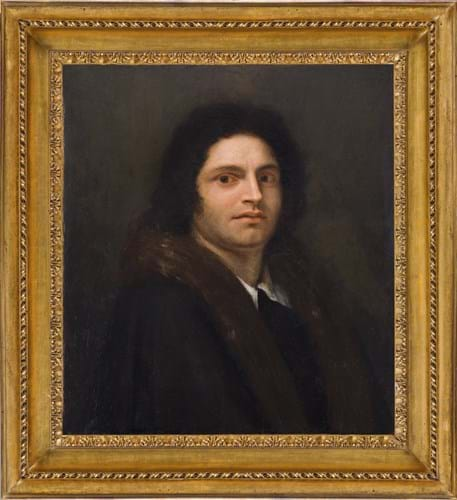
This ‘self-portrait’ of Giorgione (c.1477-1510) is actually the work of the Neoclassical artist Antonio Canova (1757-1822), most famed for his marble sculpture. However he painted this ‘portrait’ as part of an elaborate practical joke staged between him and his patron Senator Prince Abbondio Rezzonico.
In 1792, the story goes, the senator unveiled the ‘self-portrait’ to some of Rome’s leading artists including Angelica Kauffman, Antonio Cavallucci, and Giovanni Volpato. During a lunch in his home, a box containing the work was delivered and scrutinised by his guests. All agreed that it was by the hand of the 16th century Venetian Renaissance master Giorgione – apparently to the senator’s great amusement.
A year later Canova revealed himself as the artist. He had made the work more convincing, reports said, by painting over a 16th century panel of The Holy Family and used an existing portrait of Giorgione as his model.
Now, Italian dealers Damiano Lapiccirella and Francesca Antonacci have rediscovered the work and are offering it for close to £1m as part of their at London Art Week exhibition (June 29-July 6).
Lost identity
Though the bizarre story behind the painting has been passed down ever since it was picture was exhibited at the senator’s lunch, the painting itself quickly faded from view.
Following the senator’s death the work was passed to Cav Giovanni Gherardo de Rossi, who had been present at its unveiling and he, in turn, sold it to the Pozzi family after falling into debt. From there it entered a private collection around 100 years ago. The identity of the painting was not recorded when it passed through the different owners.
“Of course we knew the story of the Canova painting but we simply assumed that it had long vanished,” says Lapiccirella. But in 2016, He and Antonacci spotted the work in the home of a potential client in Rome.
Rediscovery
“We knew at once that it was a neoclassical painting,” Lapiccirella says, but it was the unusually thick board that suggested there was more to the work than met the eye.
Then, following analysis including reflectography and infrared inspection, research and consultation, the two dealers confirmed the painting’s identity. Like the stories said, the picture was painted over a 16th century picture of The Holy Family. They put the science and the story together.
“When you realise it’s a Canova it’s very typical of his style of painting, particularly in the eyes and lips,” Lapiccirella adds.
It retains its original carved and gilded frame, commissioned by the senator.
The discovery follows the appearance of one of the few autograph works ever to emerge at auction by the same artist. His Bust of Peace is estimated to make a price in excess of £1m at Sotheby’s on July 4.
The dealers will include the painting in their LAW exhibition Italian paintings through five centuries which will be held at ML Fine Art on Old Bond Street.
“This is both a masterpiece and a document,” says Antonacci. “The picture is fascinating and the story perhaps even more so.”





